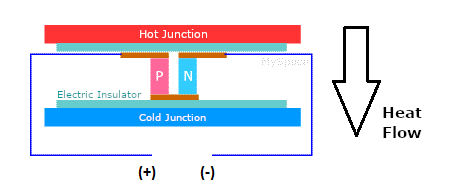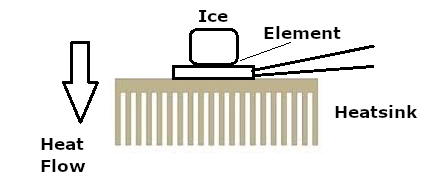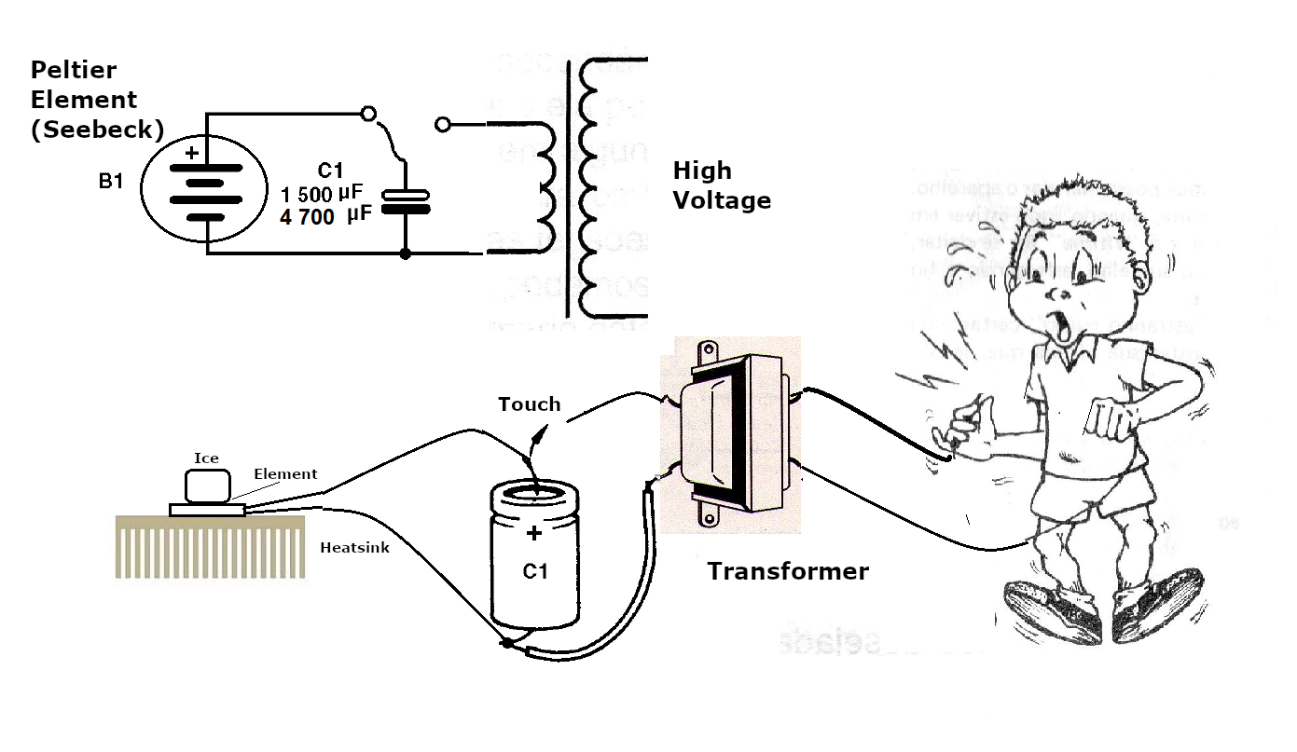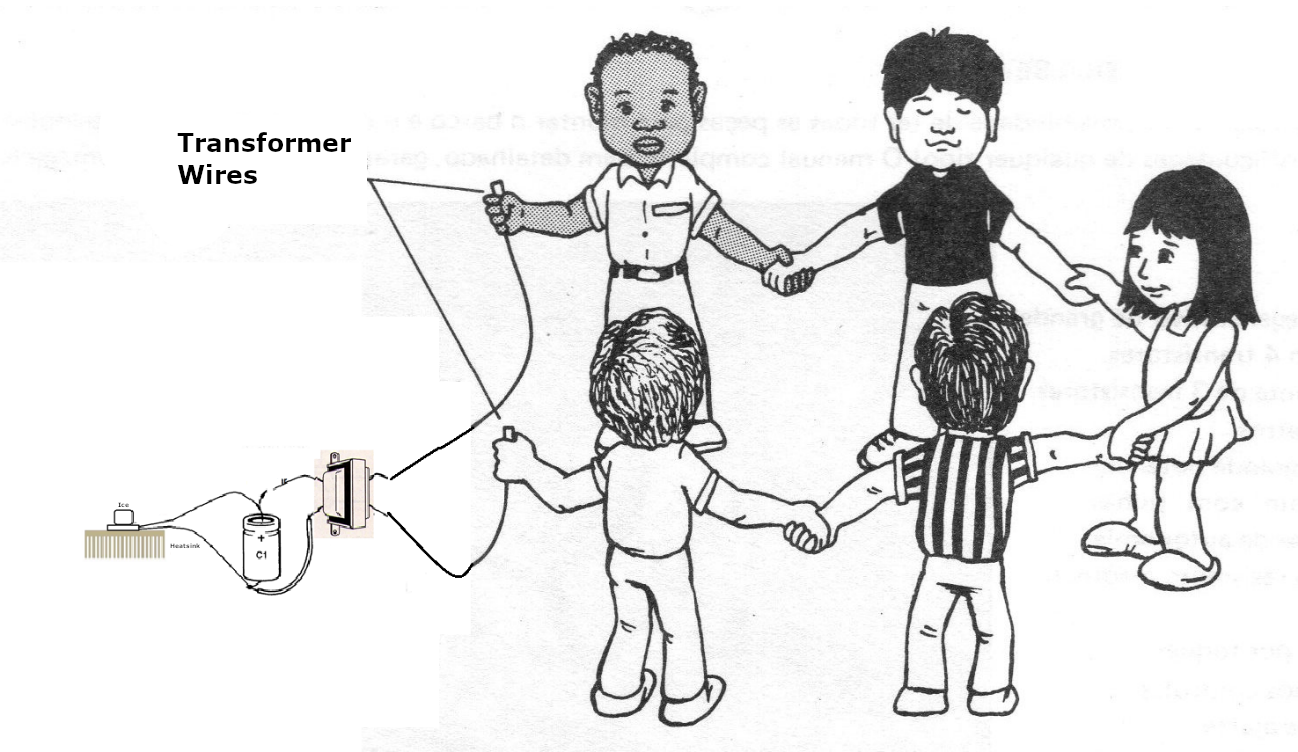We wrote an interesting article called "Ice Energy – Fire Trial" in which we teach how to convert cold energy into electrical energy, using it to drive a small engine in an exciting competition that can be proposed in schools and communities of makers. This article proposes a new challenge: extracting enough energy from an ice cube to charge a capacitor and electric shock people.
We even recorded a video (VEL14) in which our character Eltron proposes a project to demonstrate at an exhibition where he will use an ice cube to electric shock people. Of course, this is not a game, but something serious that you can implement in practice and use in demonstrations that will surely attract people's attention. It's an excellent theme for technology exhibitions, as everyone will want to know how it's possible.
So, let's see how we can draw electrical energy from an ice cube, enough to give electric shocks.
Taking Energy from the Ice
The idea is to use Peltier effect elements to convert a heat flow into electrical energy. How is this achieved? Peltier noted that if an electric current passes through a junction of semiconductor materials, heat is taken from one side and sent to the other side. So, one side cools, and the other side gets hot.
These elements can then be used in small refrigerators and to cool down electronic chips. But Seebeck also found that the opposite effect is possible. If we cool one side or heat the other side so that there is a difference in temperature and heat can flow through the junction, an electrical current is generated.

So we can get electrical energy wherever there is a heat flow.
The usual thing would be to get energy from a heated body, as it would dissipate heat by passing it through the element and dissipating it into the air. But we can do it the other way around.
Instead of heating the face of the element, we cool it down so that the heat from the warmer side flows to the cooler side, we will have a thermal gradient. This way, the electric energy is generated, and that's where the ice comes in!
Placing ice on one face of the element, heat soon starts flowing from the face that is in contact with the environment (warmer) to melt the ice, and in this process, we have electrical energy being generated. From the physics point of view, we can say that ice contains "negative thermal energy" in relation to the environment that has "zero thermal energy". Thus, the heat flow is from the environment to the ice. In this process, the negative energy of the ice is converted into electricity, or even the thermal energy supplied in the process by the ambient air.
And in practice, how we do that.
Just place the Peltier element over a metal object that can help to collect heat from the ambient and a small aluminium mug or heat sink on top of the element where we will place the ice cube, as shown in Figure 2.

The Peltier element is the type that can be purchased on the Internet.

This element has a sufficient efficiency for what we want, providing some volts and electric current that reaches 200 mA when placed in the arrangement we propose. We ran tests with different types of elements and found out that they all have the same performance.
The Experiment
We then set up the circuit shown in Figure 4, consisting of the Peltier generator (Seebeck), an electrolytic capacitor from 1500 uF to 4700 uF and a small transformer of 110 or 220 V primary and 5 to 6 V secondary with current from 50 to 200 mA. If the reader wants to monitor the capacitor charge, he can use an ordinary multimeter.
Components
B1 - Generator with one Peltier element
One heat sink (obtained from a computer cooler)
One electrolytic capacitor from 1500 uF to 4700 uF
One transformer (refer to the text)
Assemble the arrangement shown in Figure 4.
Place a small ice cube on the Peltier element. You can connect a multimeter on the lowest voltage scale and monitor the power output. Connect the wires to the capacitor to charge it. Note the polarity in the connection. Leave it charging in this way for at least 2 minutes or until the voltage stabilizes to at least 3V.
Once charged, disconnect the capacitor, keeping its terminals apart (if one terminal touches the other, the capacitor discharges). Ask someone to hold the high voltage terminals on the transformer (primary). Discharge the capacitor by touching its terminals to the transformer low voltage winding wires.
There should be a snap, and the person holding the wires gets a small electric shock. Connect a neon lamp or a small fluorescent lamp to the wires if you don't want to risk the electric shock. Use this procedure for the demonstration.
If you want to electric shock a group of people, make them form a ring, and those at the end hold the wires, as shown in Figure 5.
Contrary to what one might think, people at the edges do not take the biggest electric shock, thus showing an important property (demonstrated in course lessons) that the current intensity is the same at all nodes of a closed circuit.
An exciting demonstration is to show that with the energy of ice, you light a fluorescent lamp.
The Work - Parallel Themes
Alternative energy sources, non-polluting energy sources such as solar energy and thermal energy are essential topics for discussion in the classroom and to motivate work. In this project, we use thermal energy that can serve as a basis for elaborating the written part (report) and executed at different levels.
For elementary school:
- Research the use of thermal energy (geothermal and others)
- Explain how Peltier (Seebeck) generators work
- Discuss alternative sources of energy
For high school:
- Analyze how thermal junctions work
- Calculate the energy stored in the capacitor
- Explain the operation of the transformer
- Discuss alternative sources of energy, smart grids and energy farms
For higher education:
- Analyze the Peltier and Seebeck effect
- Calculate the energy stored in the capacitor and the discharge time to a consuming load
- Analyze the possibility of using energy stored in supercapacitors
- Analyze the use of alternative sourcing processes in smart grids and energy farms.





